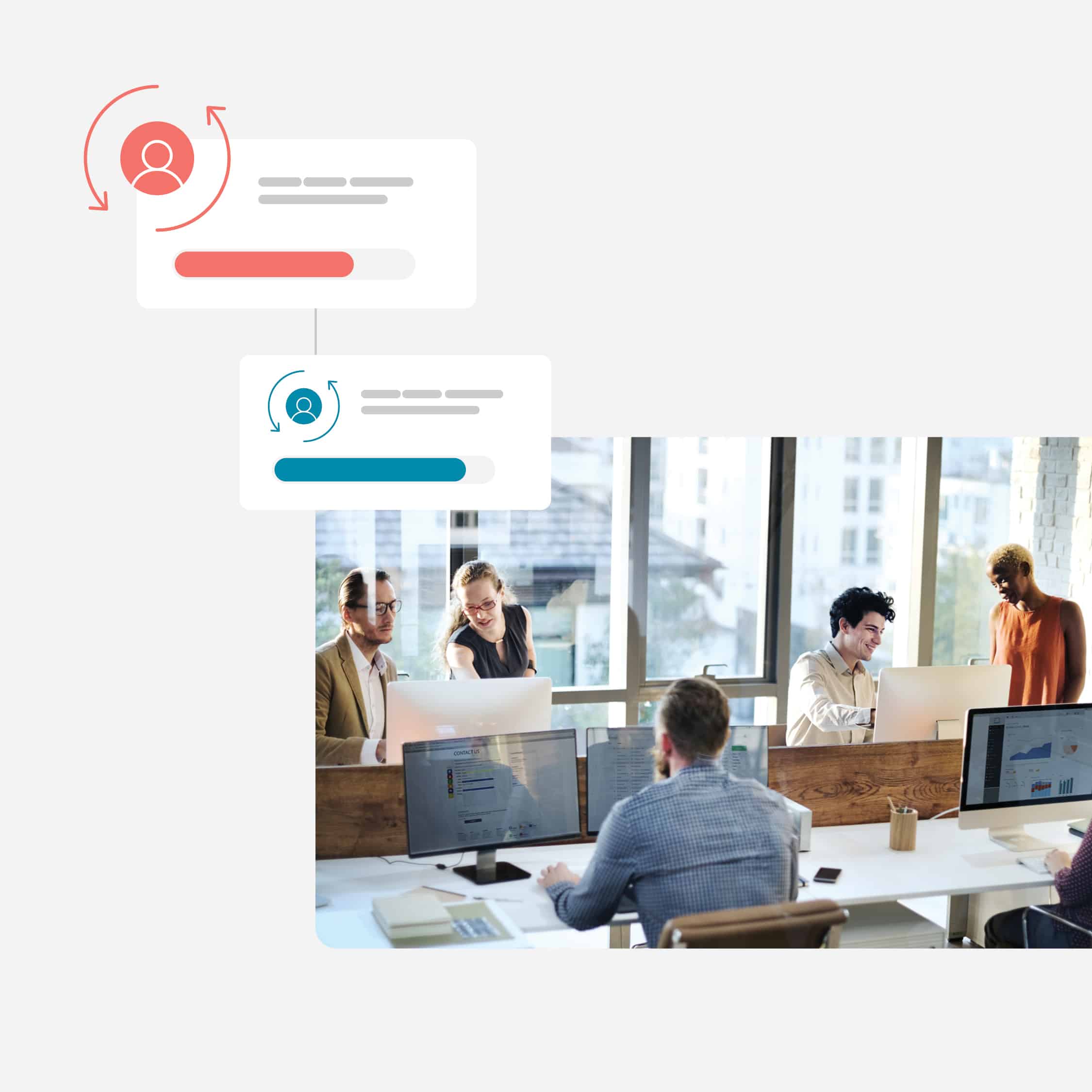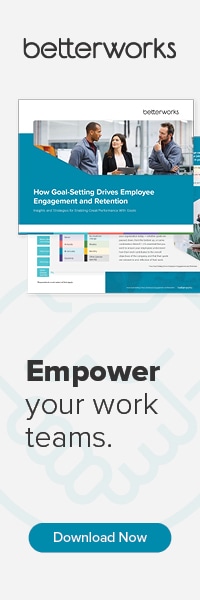If there’s one thing we’ve learned from the past few years, it’s that people are willing to take risks to find happiness at work. Rather than watching them leave, you can take control of your employee experience, help people feel happy and fulfilled at your organization, and reap all the benefits of employee retention.
Those benefits could be crucial to your success. A recent report from The Conference Board predicts that global growth will slow to 2.6% this year, down from 3.3% in 2022 and 6% in 2021. The Conference Board expects further slowing to 2.4% in 2024. The current and next-year forecasts are among the lowest in recent years. A strong employee retention plan puts your business in a position to thrive regardless of the economic climate.
Find out why retaining your workforce is so important and how you can harness the benefits of employee retention to drive your business forward.
Why is employee retention important?
Your talent strategy is the foundation for business growth. You’ll struggle to succeed and grow without the right people in the right places. That’s why programs like talent management, succession planning, and workforce planning are so critical to success.
Employee turnover can derail your organization’s strategy and growth plans, putting success at risk. As more people leave the company, your talent function goes into triage mode. They focus on plugging in new talent rather than adequately training and developing long-term employees. This response illustrates a reactive approach to retention rather than a long-term proactive strategy.
It’s hard to overstate the importance of employee retention to your business. Happy, satisfied workers provide a stable foundation for building a talent strategy that elevates your business.
Addressing these issues is within your power as an HR leader. You can improve and optimize your offerings — including pay, benefits, employee experience, and growth opportunities — to increase employee retention.
HR professionals are responsible for reducing turnover and developing an engaged workforce, especially during an uncertain economy.
What causes high employee turnover?
High turnover has a number of causes. A recent Pew Research Center report found that the top three reasons people left their jobs in 2021 were low pay, lack of opportunities for advancement, or feeling disrespected at work
Low pay and benefits
One of the top reasons someone leaves a job is because they feel underpaid and undervalued. And since more companies are posting salary ranges for their jobs, it’s easier than ever for workers to see where they have higher earning potential, where their pay stub will look better.
Benefits are a big factor in turnover, too. The cost of health care and prescription medications continues to rise in the U.S., and benefits that help keep those costs under control are in high demand. Other benefits, such as pet insurance, dependent care coverage, or more flexible stipends, are also appealing to many people.
Monitor pay and benefits trends in comparable businesses in your industry to maintain competitive offerings. Survey your employees regularly to stay on top of which benefits they value most.
Lack of opportunities for advancement
Competitive compensation and benefits are essential for retention, but they aren’t enough to keep your best talent engaged. They’ll also be looking for opportunities to advance and earn. Without a clear path to growth inside your organization, workers are more likely to seek opportunities for advancement outside your organization.
A transparent job structure and org chart can help people see their opportunities for advancement (or lateral career moves). Train managers to have regular conversations with their team members to assess their interests and to help match them to specific training programs or other options for mobility.
Feeling disrespected at work
People need to feel that their mental and emotional needs are being met at work, too. If they don’t feel included, or that their managers and peers will value their opinions, people are much more likely to leave.
Recognition programs can help people feel more acknowledged and respected for their contributions. Encourage and reward innovation, continuous improvement, and creative problem-solving from everyone in every role.
7 benefits of employee retention
Investing in employee retention has a positive impact on multiple aspects of your organization.
Stronger company culture
Higher retention contributes to a stronger, more positive culture. High turnover undermines your culture because people are coming and going constantly. There’s more disruption and less cohesion. That can be draining for people who stick around amid a culture of uncertainty and dysfunction.
When an employee stays with your company, by contrast, they’re embracing your mission while adding stability to your culture. Their choice to grow within the company signals their belief in your mission. They’ll have a greater sense of their value and what they’re capable of accomplishing, reinforcing your larger retention strategy.
Higher employee engagement
High retention supports a robust, stable culture, and can also improve employee engagement.
When the same team members spend years solving problems and overcoming challenges together, they form stronger bonds. Close teams are more likely to be engaged and invested in achieving shared goals.
And as more people build long-term careers with your company, they become symbols of the culture of growth you’ve created. These workers can experiment with different tasks and roles as they find their place within the business. That kind of public career mobility increases engagement and drives employee satisfaction.
Retained institutional knowledge
One of the most significant downsides of turnover is the loss of institutional knowledge, which is what workers know about operations, culture and the industry.
Long-tenured workers, in particular, often have a great deal of tacit knowledge that hasn’t been captured in any formal systems. Their sudden departure can create a big drag on your efficiency.
Meanwhile, an experienced team member can share stories, examples, and lessons learned with newer workers or executives, helping everyone place today’s challenges in a historical context. An employee who was a manager during the Great Recession and is now a business leader, for instance, can provide insight into how to handle the next economic downturn.
Reduced training costs
Employee turnover usually means you have to recruit, hire, and train their replacement, which can be costly. A stable workforce requires less spending on hiring and training. Instead, you can invest in strategic education and upskilling to help people grow within the company.
High-retention cultures usually feature internal mobility, which can also lower costs associated with training and development. Because internal candidates already carry high levels of institutional knowledge (such as understanding your mission, vision, and values), you can focus training investment on the specifics of the job role.
Increased revenue
Retaining valuable employees isn’t just a cost-saving; it can also improve your revenue. The buildup of institutional knowledge over time makes it easier for long-term employees to navigate the culture and perfect their tasks and processes. Teams that stay together learn to work more efficiently, enabling better business performance.
Moreover, people generally stay with an organization when they enjoy the work and culture. Happy employees tend to be more invested, engaged, and productive.
Decreased hiring and recruiting costs
High retention rates reduce your organization’s spending on hiring and recruiting. Turnover is expensive: The most conservative estimates of replacing a single salaried employee are at least one-third of their annual income. The ebb and flow of the labor market cause this estimate to fluctuate. When demand for talent is high, replacing an employee can cost more than twice as much as their annual salary.
If your high-retention workforce also has high internal mobility, you can fill many highly skilled positions internally. You can redirect the recruiting budget toward hiring lower-skilled or entry-level talent and training them. The cost of replacing a lower-tiered employee will be significantly lower than replacing someone at the management or executive level. You can also reconsider the way you hire people. Do your best to automate tasks with the help of LinkedIn and LinkedHelper’s message automation to free up your HR department from having to scroll through hundreds of leads daily.
Improved customer experience
The benefits of retention extend beyond your internal operations. Clients and customers will notice a difference, too. Long-term employees in client-facing roles build strong relationships, while experienced front-line employees provide more knowledgeable and tailored customer service.
And when these people are happy, engaged, and passionate about what they do, they’ll be more invested in designing a better customer experience. This improves how customers and clients perceive your organization and can also lead to more revenue.
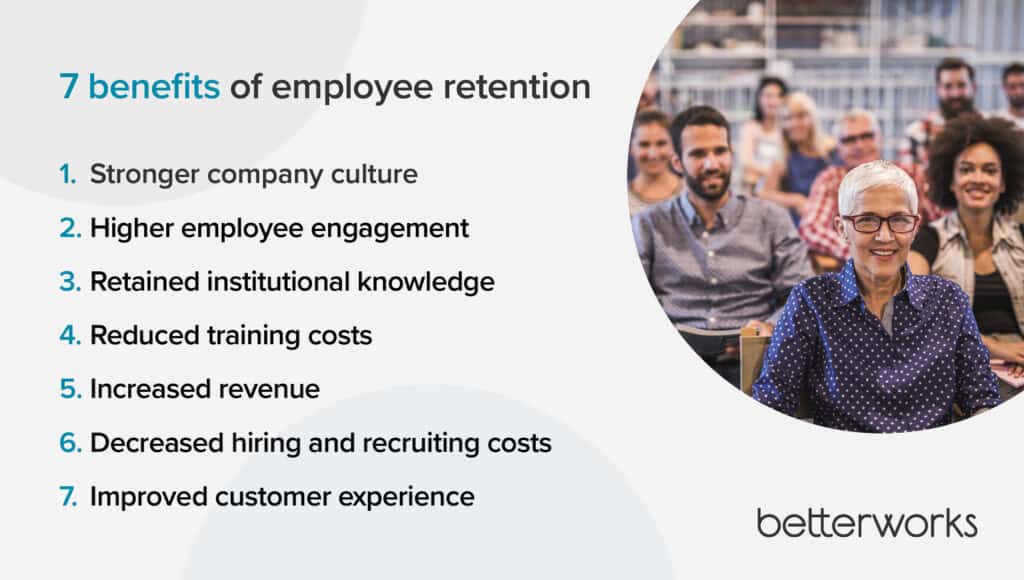
How to calculate your employee retention rate
Employee retention rates reveal a lot about how your people feel about the workplace and the compensation, benefits, experience, and opportunities you offer.
All employee rate calculations, like employee retention and employee churn rates, begin by setting a time frame (usually a year). To calculate retention, take the total number of employees at the beginning of that time frame, then subtract the number of employees who have left since then. This calculation produces the number of employees remaining at the end of the time period. Divide the resulting number by the original employee total, then multiply by 100 to find your retention rate.
For example, say a business has 500 people, but 15 employees leave during the year. Divide the number of remaining employees (485) by the total number (500) and multiply by 100, which shows a 97% retention rate.
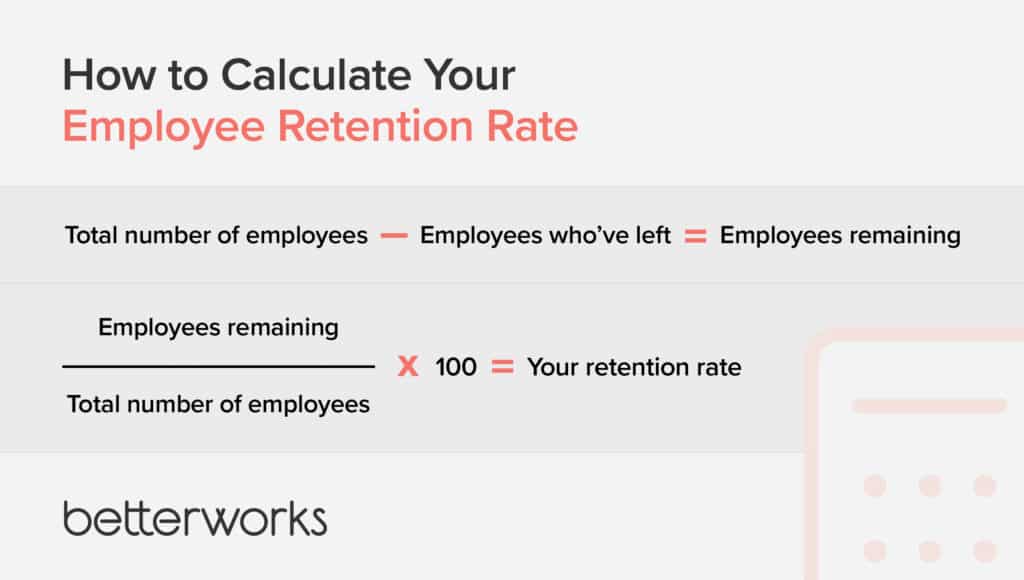
4 employee retention strategies that really work
If your employee retention rate isn’t where you would like it to be, you need a plan for turning things around. Consider these four employee retention strategies.
Develop mentorship programs
People are more likely to stay with your company when they see a path toward their career goals. But creating visibility doesn’t guarantee that workers will feel supported enough to make career moves. For some people, achieving internal mobility can be a real challenge. For example, biases built into your promotion system may be holding back team members from historically underrepresented groups.
That’s why many employers are investing in mentorship programs. When employees have executive support for their career moves, they’ll feel more empowered to express where they want to go and what they want to learn. Develop an infrastructure for pairing interested workers with managers or business leaders in the roles they aspire to.
Invest in your employees’ careers
People want to know that you’re invested in them and their potential. In our State of Performance Enablement report, one in three employees admitted that another employer’s career development opportunities could lure them away.
It’s up to you to provide internal opportunities for learning and growth. Someone may want to move from sales to engineering. Making this lateral move requires investment in continuing education. Making that commitment signals your belief in their potential and goes a long way toward fueling workforce loyalty.
Enable better performance
In economic downturns, your company has a smaller margin for error when it comes to performance. An effective performance management solution can make sure your team members are aligned around the same objectives. A great performance management program can also help support higher retention.
Invite team members to help set their own objectives based on business priorities. You’ll enable better performance by empowering them to align their goals with those of the business. These workers realize a greater sense of purpose and autonomy, which can lead to higher engagement.
Training managers to manage by objectives (rather than micromanaging) can also create a more empowering experience. Team members have the freedom to accomplish their work when, where, and how they work best. Enabling employees to contribute their best in daily work creates a more enriching, fulfilling day-to-day experience.
While these benefits help your workforce, they generate outsized returns for the business by supporting higher retention and your overall talent strategy. A high-retention workforce that empowers better performance helps your organization thrive during boom times and stay resilient during downturns.
Get recognition right
Recognition is one of the most critical pieces of retention. Everyone wants to feel valued, and fostering a culture of recognition communicates your appreciation to teams and individuals. In fact, 15% of respondents to our State of Performance Enablement report stated that recognition and appreciation for their work are significant factors keeping them with their employer.
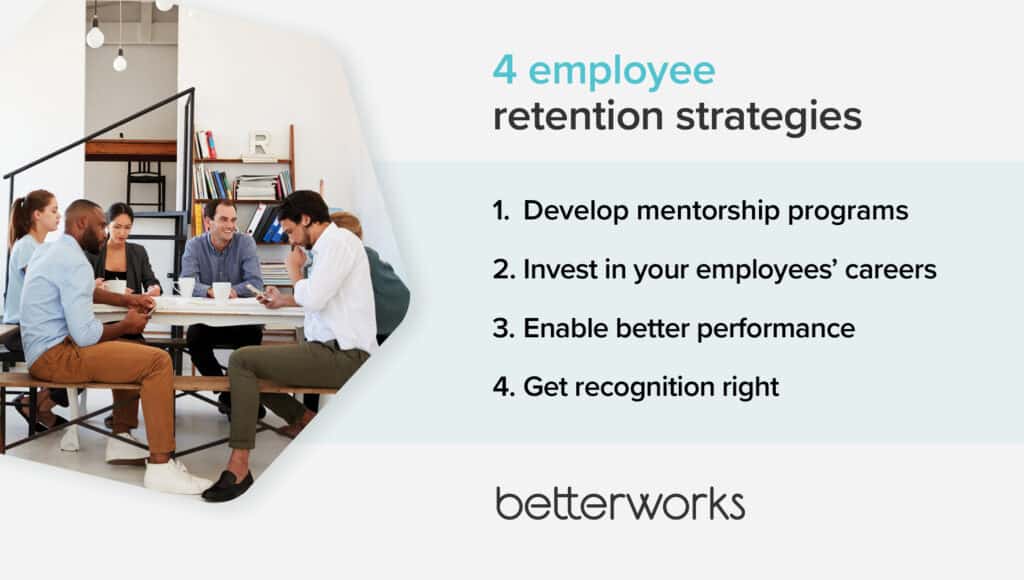
Take advantage of the benefits of employee retention
By harnessing the benefits of employee retention, you’ll develop and empower the workforce to take your business to the next level. High retention reduces lost knowledge, hiring expenses, and missed revenue opportunities. It amplifies workers’ contributions, allowing you to make the most of the talent you have. And retention drives better performance and improved business outcomes over the long term while delighting your clients and customers.
